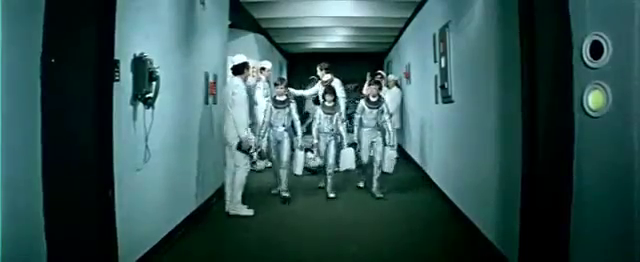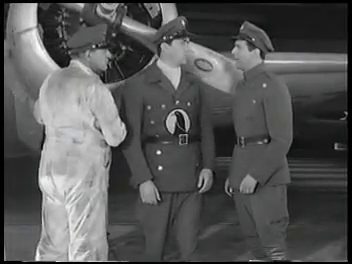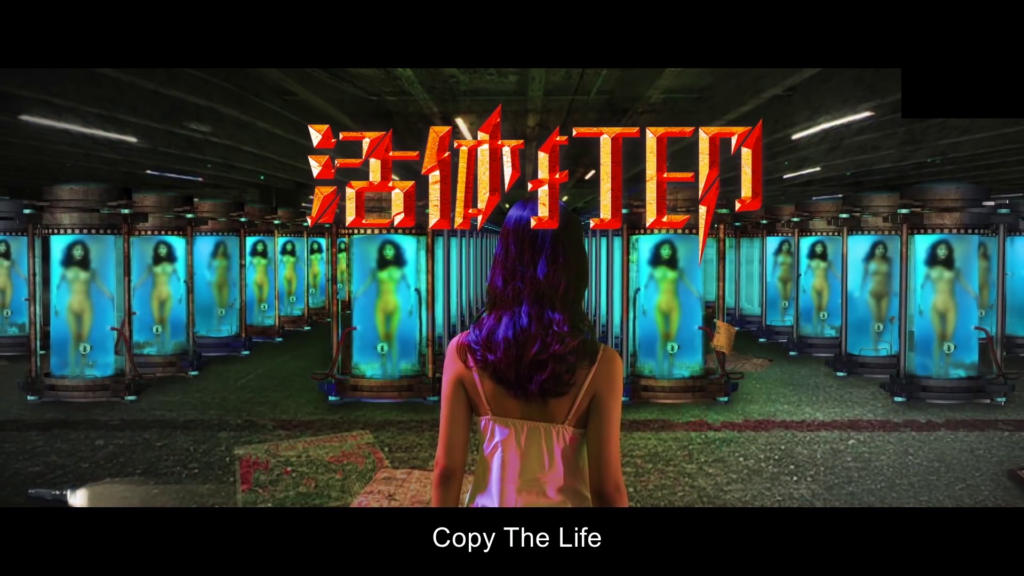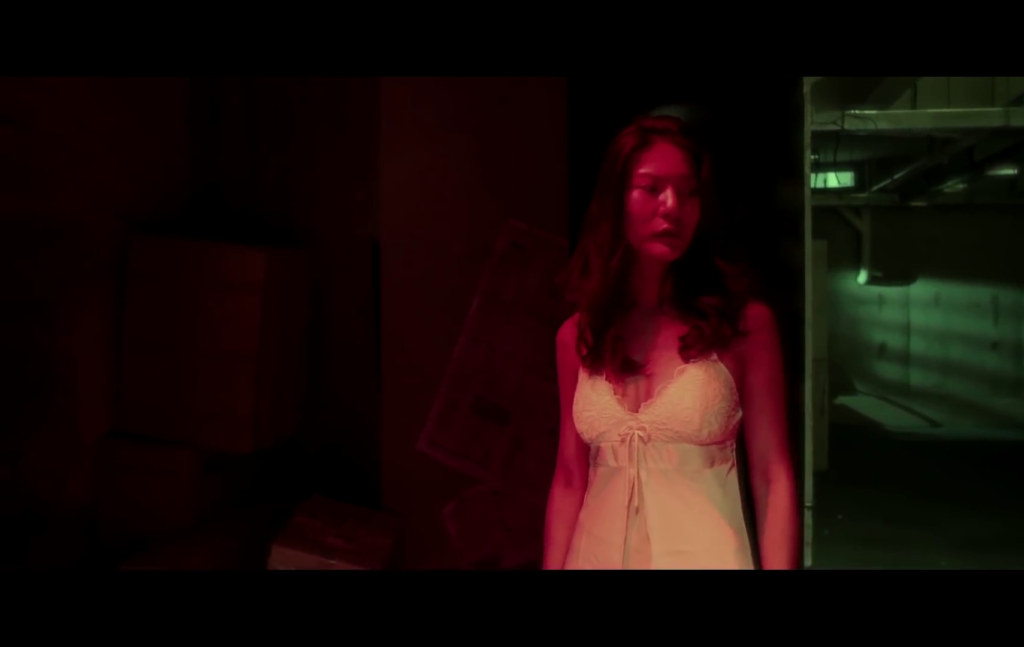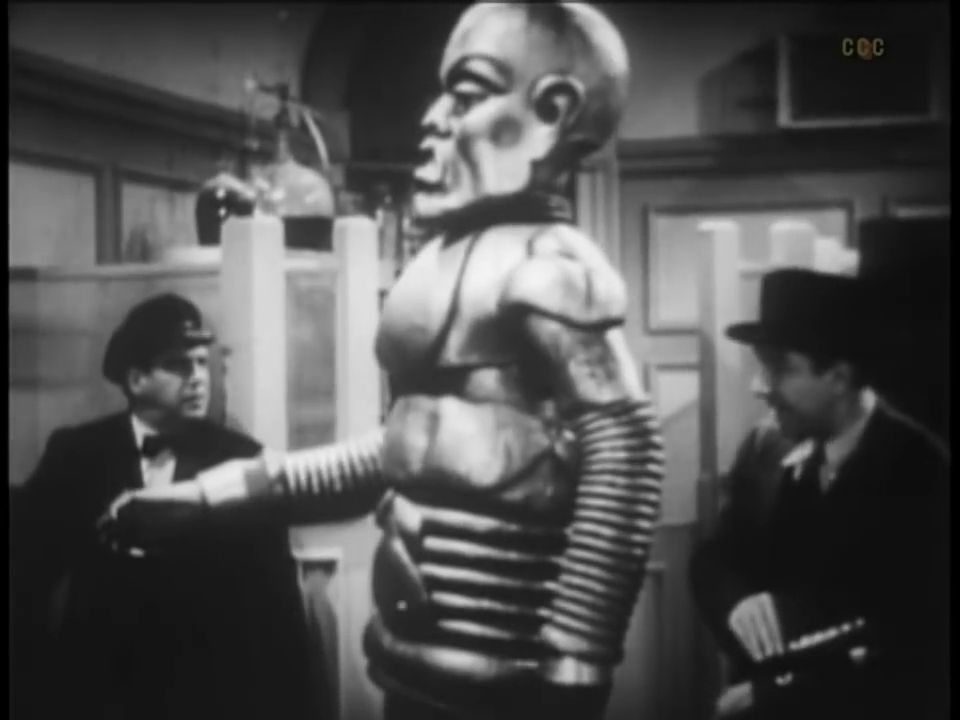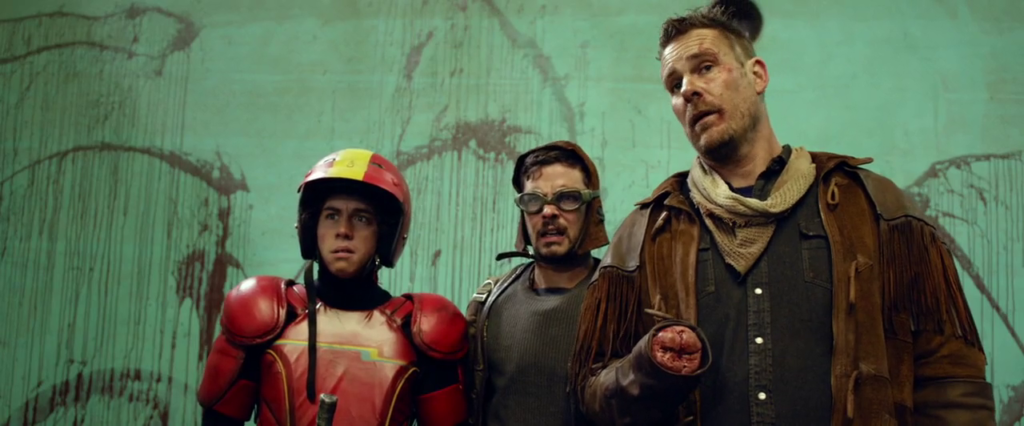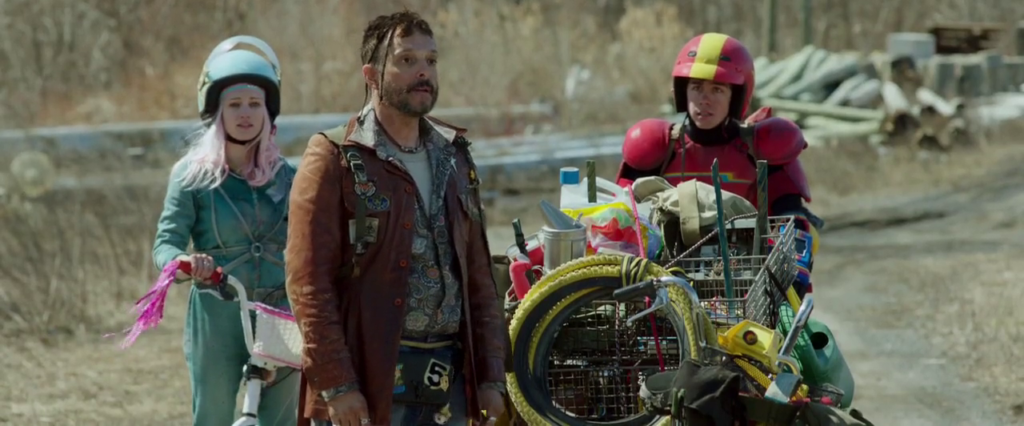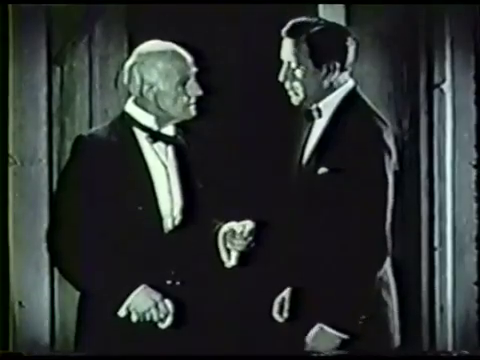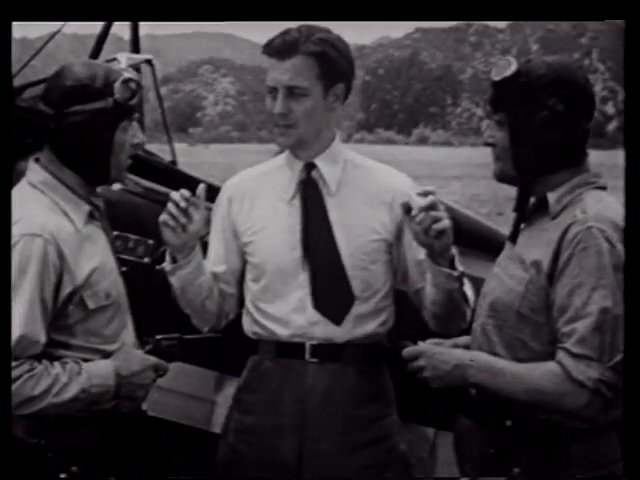-
#460 – Spy Smasher (1942)
Spy Smasher (1942)
Film review #460
Director: William Witney
SYNOPSIS: The masked hero “Spy Smasher” is captured in Paris on a secret mission to obtain plans for sabotage operations in the United States. He escapes back to his home country, where he is reunited with his brother Jack. However, the Nazis have also made their way to America shores, and the two team up with intelligence officer Admiral Corby to counter the threat…
THOUGHTS/ANALYSIS: Spy Smasher is a 1942 movie serial comprised of twelve chapters. It is based on the comic book series of the same name. The serial opens up in Paris, where the eponymous masked hero “Spy Smasher” is on a secret mission to obtain plans for a sabotage operation to be carried out in the United States. He is, however, captured, and after unsuccessful torture attempts, he is sentenced to death in front of a firing squad. Fortunately, a member of the French resistance, Pierre Durand, fakes his death, and is able to smuggle him back to the United States. The opening of this serial is quite uncharacteristically dark compared to others of the genre: The scenes of torture (implied, but shown just offscreen), and the firing squads are perhaps a more authentic look at what was happening during WWII at the time than other serials portrayed. From the outset, the serial feels a little more grown up than others, which is odd considering they were mostly aimed at younger viewers. Back in the United States, the Nazis have snuck in and are on a train to carry out their plans, when one of them recognises Spy Smasher and attacks him. It turns out that it is not Spy Smasher at all, but his brother Jack, and Alan (who is Spy Smasher in disguise) defeats the Nazis and reveals himself to his brother. The two team up with navy intelligence officer Admiral Corby and his daughter Eve (Jack’s fiancée) to counter the Nazi threat that Alan/Spy Smasher helped to expose. The rest of the serial’s story is simple enough to follow, but there’s a lot of different locations, such as Spy Smasher returning to Paris to free Pierre from the Nazis, which helps keeps things varied and interesting. The variety slows down in the latter half of the serial, but the finale has plenty of action and consequences to make it pretty enjoyable.
The characters are (as always) a familiar bunch insofar as they all follow very specific tropes that form the backbone of the serial format’s character roster. Jack and Alan are the typical young male stars that do all the action sequences and punch plenty of Nazis in the face. Admiral Corby is a typical older man that serves as the boss who receives intelligence and gives instructions. His daughter is the token female, who serves the typical role of simply being a family relation to a male character. It’s a pretty small cast, but it means that more time is focused on the actions of Spy Smasher, which is what you want to see really. The villains are Nazis. That’s it. They are mostly in their full uniforms somewhat faithfully recreated, whereas a lot of serials simply imply that the villains are Nazis, or working for a “foreign country.” The villains are led by a masked individual known unsurprisingly as “The Mask.” Despite the fairly decent costumes on the villains, the mask for The Mask is literally a piece of white cloth covering his face with some holes cut out for the eyes. I’m not sure why they bothered, since his identity isn’t of any importance, and he routinely removes it when communicating to certain people. The mask is apparently the villain from the comics, so I suppose he was just added to tie in with the comic, but he doesn’t stand out as a unique villain.
The production values are pretty good for a serial, and although there’s no exotic or novel sets, what we do get is sturdy and has a decent scale. The action scenes on top of speeding trains and the like are also well done, and deliver a good sense of danger. As mentioned the costumes are pretty good as well…apart from The Mask’s “mask” anyway. There’s also some plots involving planes and ray guns, which again add to the variety. Overall, Spy Smasher is a serial that stands above the average in terms of quality in the genre, thanks to it’s variety in the story and its grounded, consistent logic, alongside some good production values and camerawork. It’s a very good example of the wartime serials that portrayed the Nazis as the villains, without the film being simply propaganda. All in all, worth your attention if you’re a serial fan.
-
#459 – A Great Space Journey (1974)
A Great Space Journey (1974)
Film review #459
Director: Valentin Selivanov
SYNOPSIS: The All-Union Children’s Space Competition aims to find three children that will be the first youths in space aboard a new spaceship. Sveta, Sasha and Fedya are chosen from the one hundred thousand applicants to embark on the mission with the sole adult on board, Captain Egor Kalinovsky. After the ship is launched, Egor is found to be sick, and placed in quarantine, leaving the children in charge of the spaceship…
THOUGHTS/ANALYSIS: A Great Space Journey is a 1974 children’s science-fiction film based on the play The First Three, or the Year 2001 by Sergey Mikhailov. The film opens up introducing a space program that will choose three children to be the first young people in space. Out of one hundred thousand applicants from across the Soviet Union, three children are selected: Sveta Ishenova, Sasha Ivanenko, and Fedya Druzhinin. The three are sent into space on the spaceship Astra with the only adult on the voyage, Captain Egor Kalinovsky, who is in charge of the mission. When Egor is found to have a fever, that may spread to everyone else, he is placed in quarantine, leaving the children having to take charge of the ship and the mission. The story is fairly simple, being a film aimed at children, and is fairly light on the details concerning what the mission they are on actually is. Nevertheless, there is plenty that is going on in the film, as the children have to navigate through a fair amount of emergencies and strange situations as their journey continues. Not having an overarching objective hinders any sense of direction and accomplishment the film has, but nevertheless, there’s a good sense of adventure and enough variety to capture viewer’s imaginations. There’s a bit of a twist in the story that explains most things at the end, but I’ll discuss that at the end too.
The three main characters are the children that were chosen through the space program. Each of their characters are developed through flashbacks to when they were undergoing the testing, highlighting their relationships with their parents and each other. There’s also Egor, the only adult on the spaceship, who is placed in quarantine, but can still communicate to the others. One of the children, Fedya, is placed in command of the mission after Egor is quarantined, and it is hinted that he is troubled by something about the mission, but refuses to disclose it. Sasha is very animated, and teaches the other children dance moves to keep them entertained. Sveta is more headstrong and quick to rush into situations (contrasting with Fedya’s more reserved nature) and perhaps has some romantic feelings for Sasha. Between the three children, they have a good range of personalities, and at least one of them will appeal to children that the film was aimed at. Their interactions feel genuine in this extraordinary situation, and are generally likeable in their own way. There’s also a good balance between the children needing to act like adults, and also like children; such as when they complete their task running the spaceship, and immediately go get some ice cream from a nearby fridge.
The ending of the film reveals that the entire mission is actually just a simulation for the children to test their abilities. Fedya initially works it out, but keeps it secret for the remainder of the mission. You might think this is a bit underwhelming and disappointed that the children do not actually go into space…and in fact, that’s why actual soviet cosmonaut Alexey Leonov appears at the end of the film saying this exact thing. He also says that the time will come soon (?) when children will really go into space, and encourages children to continue looking forward to it and chasing their dreams, which is nice. The film also rewards the children for the completion of the simulation with a celebration and fanfare, so it still feels rewarding, and as if the characters accomplished something.
The quality of the sets and production values of the film certainly deserve some mention. The set of the spaceship is detailed, and the shots of the ship travelling through space are quite convincing given the time it was released. the model shots of the spaceship and other things also have quite a lot of detail in them. The whole aesthetic evokes the look of 2001: A Space Odyssey, which I’m sure is no coincidence. Given that the play the film is based on is called The First Three, or the Year 2001, it would certainly there’s a connection, but whether it is an homage, a parody, or knock-off, I’m not sure. The film was also apparently in production for two years, which I think shows in the look of the finished product. There’s also some musical interludes which don’t really fit in too well, but again probably something children would enjoy. Most notably, the song’s were written by a young Alexey Rybnikov, who would become one of the Soviet Union’s and subsequently Russia’s most famous composers, apparently in no small part due to the popularity of the soundtrack of this film.
Overall, A Great Space Journey is a fun little adventure that I’m sure its target audience would have enjoyed. The film is well constructed, and great effort had obviously been taken to make detailed and engaging sets. The characters themselves are relatable and distinct, without being too much of walking tropes, and the story has plenty of things going on in it, even if it lacks direction or purpose sometimes. It packs in a fair amount of detail and adventure in just over sixty minutes, and with some decent editing, always has something interesting going on.
-
#458 – Blackhawk (1952)
Blackhawk (1952)
Film review #458
Directors: Spencer Bennet, Fred F. Sears
SYNOPSIS: The elite group of air pilots, The International Brotherhood, led by the heroic Blackhawk thwart threats to the country without the use of weapons. They are tasked with stopping a foreign spy and her various schemes, leading to a series of daring adventures.
THOUGHTS/ANALYSIS: Blackhawk is a 1952 serial comprised of fifteen chapters, based on the comic series of the same name. The action centres around the group of air pilots called The International Brotherhood, a group of former WWII pilots led by the heroic Blackhawk. They are assigned the task of bringing down a foreign spy named Laska, who is working for a mysterious Leader. The story revolves around Blackhawk and his boys foiling Laska’s plots which are fairly varied throughout the fifteen chapters. There’s no real overall plot other than just stopping Laska; there’s some smaller plots concerning death rays and recovering new energy sources which would be the full plot to some other serials, but this one condenses each of these plots into two or three chapters, which keeps things somewhat varied and interesting, as some serials that hinge around just one of them get stale very fast. However, having very little to tie the whole serial together makes it suffer a lack of direction. On the other hand however, it’s just good guys chasing bad guys, and that’s all it needs to be. If you’re watching a serial, you won’t be expecting a complex narrative, and they’re mostly for younger viewers as well, so they just want to see the good guys fight the bad guys, and on that point the serial has enough action to make it interesting enough. You also have three or so chapters in Mexico in a more self-contained story, which would have been an optional part for cinemas to purchase depending on whether they bought either the twelve chapter or fifteen chapter version of the serial (a fairly standard practice at the time).
The heroes are a group of former WWII air pilots that work together to take down foreign enemies in their planes. They also make a point that they don’t use guns or weapons, but never explain why. Perhaps it’s something they did in the comics. The head of these pilots is Blackhawk, who is a very typical protagonist, being the young-ish, stocky man who gets to throw plenty of punches. The rest of his team don’t have much character themselves, and just serve as an extra pair of hands for piloting planes and throwing fists in a fight. The villains are also fairly forgettable, with the usual cast of henchman identified as working for the “Reds,” signifying the shift in America’s enemies after WWII. Laska, who serves as the main villain is played by Carol Forman, who played quite a few similar lead female villains in serials such as The Black Widow and Superman. She knows how to play the role, but her character is never given any motivations or depth, and simply serves as a simple villain. There’s also a mysterious Leader who gives Laska her orders, whose identity is kept secret until the very end. He only appears very sporadically, and his identity has no impact on the story. In fact, I didn’t even recognise his character as it was one that was apparently killed off early in the serial.
Produced in 1952, after both WWII and the peak of the serials, Blackhawk has little to offer the genre. With serial veteran Spencer Gordon Bennet being one of the directors, the fight scenes are decently co-ordinated, and there’s some variety in the shots, but nothing too special. A lot of the climaxes of the chapters seem to end up in factories for whatever reason, but there’s some aerial combat too and the usual vehicles going off cliffs. As mentioned, the serial was released after the peak of the format, so there’s nothing special to write about. Even the spike in the popularity of war heroes as characters in serials that started after WWII was starting to wain in 1952 in favour of looking to the future with science-fiction and the space race. As such, this is the last serial that focused on air combat and planes. Overall, Blackhawk is a pretty standard serial, but fails to offer anything special.
-
#457 – My Girlfriend is a Duplicate (2021)
My Girlfriend is a Duplicate (2021)
Film review #457
Directors: Xing Guangjun, Tu Biao
SYNOPSIS: Chen Fei often wakes up after having a dream where her boyfriend Ma Jia tries to choke her. Ma dismisses it, but when Chen gets suspicious about Ma’s work, she discovers a secret laboratory under their home, within which a number of clones of her are being stored. It turns out that she herself is one of these clones of Ma’s girlfriend that he accidentally killed, and that the cloning technology is being sought by a nefarious organisation…
THOUGHTS/ANALYSIS: My Girlfriend is a Duplicate is a 2021 Chinese romance sci-fi film. It is based on the novel “Dragon Fleet” by Tu Biao, who also co-directs this film. The film centres around the young couple Ma Jia and his girlfriend Chen Fei. She is beset by bad dreams about being choked by her boyfriend, which he dismisses as just stress. Ma himself is heavily distracted by his research, which brings in no money for them, and is an added source of stress. When Chen gets curious about the basement of their house, which Ma maintains is just full of junk. When Chen eventually makes her way down there to investigate, she makes a startling discovery: a large number of clones of herself in suspended animation. She eventually learns from one of the other clones that they are all – herself included – clones of the original Chen Fei, who was Ma’s girlfriend before he accidentally killed her. However, he was able to “print” clones of her thanks to the research he has been doing that builds upon his Father’s own research; part of a secret government project to enhance the health of its citizens. The story has a fair amount of different elements in it from romance and science-fiction, so the story has some variety in it. The science-fiction aspect is the most interesting aspect of it, as we learn about the couple’s past. The romance aspect isn’t developed very much, and plays out with beginning as a typical young couple, and never really exploring how this discovery would affect their relationship. When Chen makes the discovery, the film shifts almost entirely to the science-fiction genre, with a lot of the story told through flashbacks. At just over an hour long, we don’t see anything more than these series of flashbacks and a brief follow-up focusing on the consequences of it.
The cast of the film is minimal, with the couple being the main point of focus for relationship drama, and a villain who emerges near the end. There’s some dialogue involving another clone of Chen, referred to as No. 126, and the ‘current’ clone of Chen, but it seems to set her up as her own unique character and then never go anywhere with it. I’m not sure if you’re supposed to empathise with Ma, given that he did kill his girlfriend, and has to continue re-cloning her as the clones have a fairly short lifespan. The ethics of the whole process seems very much unexplored, which seems odd for a science-fiction film, but less odd when you consider which country it is produced in.
In terms of production, the film isn’t up to the standard of big budget Hollywood films: the editing is awkward, and things often move around between shots, which disrupts the continuity. There’s also the rather unconvincing special effects and the wooden acting that doesn’t convey the powerful feelings that this couple are supposedly supposed to have for each other. The most interesting aspect of this film, as with most films produced in country’s with strict censorship programs, is how the film has to do and show certain things to be approved for release. At the start, we are told about a secret government bureau made to improve the health and wellbeing of the Chinese people, but it is done in such a way that it doesn’t make the government look bad or keeping dark secrets from the public. As such, any more details about how secret the bureau is and what it actually did is not addressed. The villain is outlined as being a traitor who wants to steal the Bureau’s research in order to sell it to China’s age-old enemy Japan. There’s also a scene where the villain goes to pray at an altar with what I presume is meant to be the Chinese Premier, to which Ma calls him out to “stop pretending” that he is paying his respects. This again is obviously reinforce the message that the villain is not part of the government and is this traitor that deserves no sympathy. As mentioned earlier, sci-fi films such as this would usually address the ethics of the concept of cloning, and whether it is right to do it. This film completely avoids saying whether it is right or wrong: the only wrong it highlights is selling the secrets to a foreign enemy. It is perhaps important to highlight that the Chinese government is often found at the forefront of cloning research, and any kind of critique could easily be seen as a critique of government research. The trouble is that such explorations of ethics and possibilities of science and technology really is at the core of the science-fiction genre, and in completely avoiding that part of it, this film feels quite pointless and empty.
-
#456 – The Phantom Creeps (1939)
The Phantom Creeps (1939)
Film review #456
Directors: Ford Beebe, Saul A. Goodkind
SYNOPSIS: An evil scientist named Dr. Zarko has developed inventions that he intends to use to take over the world. With the government and foreign spies constantly trying to get him to get a hold of his inventions, Zarko is uninterested until his wife his killed, when Zarko swears vengeance against the world. Faking his own death, he adopts a new disguise and sets to work. Bob West, a government agent, works together with Dr. Frank Mallory, Zarko’s once-assistant, and journalist Jean Drew to try to foil Zarko’s various attacks and the spies who want his work, while beginning to suspect Zarko is not dead after all…
THOUGHTS/ANALYSIS: The Phantom Creep is a 1939 film serial composed of twelve chapters. Most notable for featuring film icon Bela Lugosi as the villain, it would also be the last movie serial he would star in. The serial starts off introducing Lugosi’s character Dr. Alex Zarko, a brilliant scientist but a bit eccentric as he likes to play tricks on the government agents and foreign spies that are attempting to buy or steal his inventions. He takes everything in good stride until his wife is killed, and the thought of vengeance on the world completely consumes him, and begins using his inventions for evil after faking his own death. Government agent Bob West teams up with Dr. Frank Mallory, who was Zarko’s assistant who wanted him to donate his inventions to the government for the benefit of mankind, and left when he refused. Also working with Jean Drew, a journalist at a national newspaper. Together, they take on the spies that are attempting to get a hold of Zarko’s inventions, and investigate whether Zarko is really dead. One thing that stands out in this serial is all the various inventions that Zarko uses. He has invisibility, an eight-foot robot, robotic spiders that can paralyze people and also a device to put people into suspended animation. Normally, only one of these inventions would serve as the main plot point for a serial, but this serial gives us all of them. While all of these inventions have been the focus of other serials, having them all together like this gives some much needed variety, as different chapters focus on different things, and are used fairly creatively in the various schemes and set-ups. The plot has a lot of back-and-forth with the characters ending up at Zarko’s old home many times, only to be continually come under attack and being surprised when they do so. The story goes round in circles and lacks some direction with so many different things happening, but it’s better than nothing happening, which is what many serials do when they try to stretch very little over twelve to fifteen chapters.
In terms of characters, they are nothing special: there’s all the usual characters from the young action-hero, the sole female etc., but the star of the serial is obviously Bela Lugosi, who gets first billing, and is always the star of every film he is in. His performance is similar to his usual roles (he is the villain in a few serials), but he undoubtedly draws in the audience for those very roles. He also has an assistant called Monk, who plays the role of the idiotic assistant who bungles and sometimes intentionally sabotages Zorka’s plans provides some comedic value, but is mostly there to give Zorka someone to interact with and get his wrath out on.
With all of the inventions and devices that form the backbone of the action, the effects are fairly well pulled off. Of course, the mechanical spiders and the floating objects being carried by an invisible Zorka aren’t convincing nowadays, but there’s definitely worse I’ve seen in the serials of this time. One thing of interest is that there’s not many fistfights or gun shoot-outs, which is usually what most of the action in serials consist of. This serial has all of the inventions to replace that, but also focuses a little more on setting up large scale explosions or vehicle crashes that form the chapter’s cliffhangers. The chapters are also fairly longer than usual, going to about twenty minutes whereas some serials only have fifteen minute chapters with a lot of reused footage from a previous chapter. As such, I think you would get your value for money going to watch this at the theatre in comparison to others. Overall, The Phantom Creeps has a fair amount to offer viewers with its imaginative inventions, and Lugosi’s star quality. The story lacks direction sometimes and the other characters fall flat due to some dull acting and lack of anything unique about them, but overall the serial has enough to make it an above average venture.
-
#455 – Turbo Kid (2015)
Turbo Kid (2015)
Film review #455
Directors: François Simard, Yoann-Karl Whissell, Anouk Whissell
SYNOPSIS: In the post-apocalyptic world of 1997, a boy known only as Kid, who idolises the “Turbo Rider” comic book character, stumbles upon a girl named Apple, who starts following him around everywhere. When the local warlord Zeus starts pressing his terror across the wasteland, Kid discovers the remains of the real Turbo Rider, and along with them, the superhero powers he needs to take on Zeus himself…
THOUGHTS/ANALYSIS: Turbo Kid is a 2015 post-apocalypse sci-fi film, it is an expanded version of the six-minute short film T is for Turbo from 2006. The film is very much an 80’s retro-styled post-apocalypse film that were produced in overwhelming numbers throughout the decade (mostly inspired by the success of Mad Max). The film starts off introducing Kid, a teenage boy who lives in this wasteland by scavenging, and who idolises the comic book character “Turbo Rider.” One day he stumbles upon a bizarre young woman named Apple, who starts following him around everywhere. The pair get caught up in a fight with the local warlord Zeus. The story of the film is fairly straightforward and easy to follow, and while the stakes never seem to be too high, the focus is on the characters and their relations to each other, rather than saving the world. It definitely has that Mad Max feel in terms of the story, with minimal worldbuilding or lore into how everything was destroyed and how people survive in this world, which is more or less in keeping with the genre, which usually gives off an “end of history” vibe in that after the world is destroyed, the question of “why?” doesn’t have much meaning, particularly in comparison to the question of survival.
Kid stumbles upon the remains of the real “Turbo Rider,” and takes his superhero suit and laser blaster thing to become him, and this gives him the power to take on the villains. This also feels very much like another classic 80’s trope: the revenge flick, in which a wimpy teenage kid suddenly gets the power to take revenge on everyone that wronged them. The obscure film Laserblast (though released in 1978) is one that particularly stands out to me. This is also a very sudden realisation that Turbo Rider isn’t just a comic book character, but is apparently a real person in this universe, which is not hinted at all before this reveal. Perhaps it is a sign that a destroyed world has no need to remember superheroes. When Kid puts on the suit, he takes up the mantle of the superhero in this strange new world, and as his connection to other characters and his past is revealed. The cast of characters on the whole have their own personalities and roles, and while none of their characters are particularly noteworthy or unique, you get a sense of the entirety of their character, given that in a post-apocalyptic world, most people don’t have multi-layered personalities and interests, and instead rely on their base instincts to survive.
The 80’s aesthetic extends to the soundtrack, which is very synth-driven, and while the budget is fairly low for the film, the cheaper CGI also feels more suitable to its aesthetic. The majority of the film relies on practical effects, particularly in relation to the use of gore; and there is a lot of gore. This is also very much in keeping with the exploitation and revenge films of the time where those who have wronged our hero often end up being disembowelled or mutilated in some way. There’s a nice contrast between the colourful superhero element of the film and the excessive gore that again reflects an age of cinema when age ratings were all over the place. The practical effects of the gore lead to some pretty fun and absurd situations, particularly when the body parts land on someone’s head and a totem pole of severed torsos start piling up. It’s this sort of thing that makes the film quite creative. Turbo Kid is overall quite minimal in it’s story and world setting, but excels in some ridiculous and over-the-top special effects that create some visceral gore which equally nasty and funny. While there are many films that set themselves up as a love letter to the 80’s, Turbo Kid also follows that trend while not feeling like its not afraid to push itself further, and allowing itself not to be constrained by the usual tropes associated with it. The low budget I think hampers the ability to do something more grand and spectacular with the whole superhero element, but it’s a fairly decent film that has you connecting to the characters and immersing you in familiar tropes that are comfortable and recognisable, but still able to throw in a few surprises.
-
#454 – Radar Patrol vs Spy King (1949)
Radar Patrol vs Spy King (1949)
Film review #454
Director: Fred C. Brannon
SYNOPSIS: A new radar defense system is being constructed that will cover the entire United States, but it’s completion is being interrupted by a series of attacks led by neo-nazi spy John Baroda and his henchman. Chris Calvert, agent for the Radar Defense Bureau, is assigned to supervise the completion of the radar with the help of Joan Hughes, who is in charge of the project. Together with Mexican agent Lt Manuel Agura, they work to complete the radar station while stopping The Spy King Baroda and his henchman from preparing a foreign invasion…
THOUGHTS/ANALYSIS: Radar Patrol vs Spy King is a 1949 serial comprised of twelve chapters. The serial opens up with the usual display of explosions signifying attacks that are disrupting the completion of a new radar system across the United States. The attacks are being led by “The Spy King” John Baroda, alongside his assistant Nitra and their henchman, who intends to disrupt the radar system in aid of a foreign power. Radar defense bureau operative Chris Calvert is assigned to the project, being developed by Joan Hughes, and they work together with Mexican agent Lt Manuel Agura to bring down the Spy King. The plot follows a very typical serial format, with each chapter usually beginning with the heroes or villains explaining what is going to happen in the current chapter, and then…you watch it happen. There’s never any real surprises, and the set-ups and chase scenes have all been done before. There’s a fair amount of explosions and action that form the basis of the cliff-hangers, but they are resolved in a nonchalant way as usual.
Heading up the heroes is Chris Calvert, the typical male lead with no distinguishing features whatsoever. Joan Hughes as the typical sole female character, although she does have a job other than secretary or reporter, and she only gets kidnapped once, both of which are rare for women in these serials. The villain is rather uninteresting, and the character of a Neo-Nazi spy is a trope that was used during the war and a while after for villains, as the fear of “the enemy within” and saboteurs that live among us was a theme that was quite powerful, and continued for many years after. I recognise some of the actors as being in other serials, which is a sign that I have watched way too many of these, and also that a lot of them are completely interchangeable in different serials; the actors that play the henchman always play them, and a lot of the female characters are played by the few female actors of the time.
As mentioned, the action scenes and explosions are decently done, and give the serial a bit of excitement, but there’s very little in terms of the plot or characters which sets itself apart from any other serial. The cliffhangers are sometimes a bit more inventive, but that’s all that stands out. Given that this serial came out past the peak of the format’s popularity, there is not much original that could have been done. The acting shows it’s weakness in the dialogue that awkwardly explains the plot rather than showing it, but for the rest of the time it’s passable. Overall, Radar Patrol vs Spy King is nothing special, and falls into the large pile of forgettable serials. It doesn’t have any huge problems, but avoids anything too disastrous in its production to make it any less than average.
-
#453 – Black Oxen (1923)
Black Oxen (1923)
Film review #453
Director: Frank Lloyd
SYNOPSIS: In New York high society, the appearance of a young woman named Mary Ogden who is the spitting image of a woman who has not been seen for thirty years after she left to marry in Austria. Her appearance causes a stir with the older members of high society, as they wonder how this woman can look exactly the same as a woman from thirty years ago. Lee Clavering, a member of the society, starts to take notice of her, which draws the scorn of Janet Oglethorpe, who desires Lee for herself. However, Mary has a dark secret that may drive Lee away forever…
THOUGHTS/ANALYSIS: Black Oxen is a 1923 silent film based on the book of the same name by Gertrude Atherton. The film is set in New York’s high society, where the most prominent members of society mingle in the theatres and the like. One night they notice a new lady, Madame Zittany, who is the exact image of Mary Ogden, who left to marry a count in Austria some thirty years ago. Her appearance causes quite a stir, with some believing her to be an illegitimate child of Mary’s. Lee Clavering, a member of this high society, starts to spend time with her and falls in love with her. The film is very much a romance film, but the mystery of Countess Zittlany provides an interesting twist to a typical story. It is very rare to see romance films blend with a more bizarre mystery, so it definitely stands out. The plot moves along at an even pace, probably helped by being based on a book. The themes of romance and high society contrasting with the more wild and free youth provides a good support to the mystery of the Countess, who is seen differently between the different generations.
The characters are well-defined and are recognisable by playing specific roles. Lee as the lead is described as being a “secret romantic” inside his disinterested exterior, leading to the women trying to get him to open up. He’s not particularly animated or interesting, but serves as a blank slate for male viewers to project themselves into I suppose. The women are by far the most interesting characters: The mysterious Countess has her mystery, but not much of a personality trait that is recognisable. Jane Oglethorpe is the elderly matriarch of the society, and represent some very traditional values, while Janet Oglethorpe, her granddaughter, represents the youth culture of partying and independence. The young people are referred to as “Flappers,” which isn’t a word you would hear nowadays, but probably still represents a similar divide between generations, which is pretty interesting to see in a film that is nearly a hundred years old. I think Janet particularly steals the show, as her chaotic actions really disrupt the norms of high society and add an element of unpredictability to a society that is mired in tradition and expectations. One particular moment when she refers to her grandmother and her associates as “tombstones” was genuinely funny, as you don’t really expect such an upfront performance in this era.
The science-fiction element of this film is part of the mystery of the Countess, who it turns out is actually Mary Ogden herself, rejuvenated through x-ray experiments and glandular surgery. It isn’t explained anymore than through images of a letter written to Lee confessing all of this to him, but this is a romance film rather than a sci-fi one. As mentioned, the film is based off a book of the same name that was both controversial and very popular. Maybe the idea of a woman altering her looks to look younger than she is was seen as deceptive, or maybe the “flappers” and their disregard for societal norms was frowned upon. Either way it does seem to be something that would have upset certain members of society. Mary’s reasons for undergoing this de-aging treatment aren’t personal, but rather to pretend to be her own daughter (when she in fact had none) to ensure the stability of Austria, as she married a Count there when she disappeared from New York thirty years ago. In pretending to be the descendent of herself and the Count would provide a sense of stability for the country. It’s a long-winded reason, but I think it’s meant to emphasise that she did not do this to simply look younger and re-live her youth, or steal eligible men, which is what her contemporaries seem to think.
The ending of the film is not available, but apparently it ends with Lee eventually marrying Janet instead of Mary, which the film doesn’t really set up from what I have seen. I don’t think the story is meant to “punish” Mary for her deception, but rather validate Janet’s free-spirited approach to life. Maybe that’s why the film is controversial in that it “rewards” Janet’s attacks on tradition with the hero (as far as marriage is the reward anyway). It’s obviously an old-fashioned film with it’s ideals firmly rooted in it’s time, but it’s also not scared to attack those traditions which is quite relatable today, and it shows that the gap between generations is pretty universal. Overall, Black Oxen is a decent silent film, with good acting, set designs, and a tight story that is clear despite it being silent. The performances are particularly strong and convey the specific personalities of all the characters very well. The sci-fi aspect raises some moral and ethical dilemmas, and it’s consequences are explored with enough detail to set the film apart from it’s contemporaries and make it quite memorable.
-
#452 – Ace Drummond (1936)
Ace Drummond (1936)
Film review #452
Directors: Ford Beebe, Clifford Smith
SYNOPSIS: International Airways are planning to open a new air route through Mongolia, however, their airplanes are coming under attack by a mysterious villain who calls himself “the Dragon.” Ace pilot and G-man Ace Drummond is called in to investigate and put a stop to The Dragon’s plans to secure a secret mountain of jade for himself…
THOUGHTS/ANALYSIS: Ace Drummond is a 1936 Universal Pictures serial comprised of thirteen chapters, based on the comic strip of the same name. The comic was created by Captain Eddie Rickenbacker, one of the most famous U.S. pilots in World War I. The serial starts out with attacks on numerous airplanes owned by International Airways, who are working to establish a new air route through Mongolia. Ace Drummond, a pilot and “G-man of the air,” is called in to investigate the incidents, which are being masterminded by a criminal organisation led by a man known only as “The Dragon.” From there, the serial unfolds in a typical fashion, with Ace and his friends taking on The Dragon’s henchman in fistfights, shootouts and in the air. There’s plenty of story elements that fill the serial, and the story has a direction as situations change, which is something that many serials don’t do. The main plot of the serial is still a back-and-forth between the heroes and villains, but there’s some development with the characters and variety of settings that keep things relatively interesting. The plot concerning an airline and a secret mountain of jade isn’t the most exciting story, but there’s enough going on to not worry about the end goals.
The characters are a very typical cast of serial characters, starting with the youthful action hero Ace. There’s nothing too special about him, but he does sing…the exact same song nearly every chapter. It’s something to make him a little unique I guess, but other than that he’s just the standard lead. Peggy Trainor is the sole female character that is looking for her kidnapped relative, which is one of about only three roles that female characters got in these serials. Jean Rogers, who plays Peggy, also played Dale Arden in the Flash Gordon serial in the same year. The rest of the supporting characters are pretty unremarkable. A lot of the serial is set in a monastery, where many monks live alongside the Grand Lama. I assume that it’s supposed to be Buddhism in all but name, but I don’t think any effort was taken to accurately represent the culture, as with any non-American culture in this era. There are, at least, some of the Asian characters actually played by Asian actors, although the Grand Lama and some of the more prominent Asian characters are white actors made up to ‘look’ Asian. The Dragon doesn’t really do much as the villain: he communicates through some kind of spinning fan (I don’t know how it works), and he is suspected to be one of the people working with the airways, but that element of mystery is fairly commonplace. Each chapter ends with a pretty cool looking dragon model breathing fire as he proclaims “The Dragon commands it!” As mentioned, there’s a good variety of settings that the serial takes place in. The plane fights are decent, and the fight scenes are fairly well choreographed. The acting is decent from the main characters, but a bit stifled through some of the other characters. One more unique thing about is that the intro of each chapter begins with a recap of the previous one in the form of a comic strip, which is reminiscent of Ace’s origins.
Overall, I would say Ace Drummond is a decently crafted serial that while doesn’t provide anything spectacular from the characters or setting, still has a decently flowing story and enough action to elevate it above the average quality of these serials.
-
#451 – Gingerdead Man vs Evil Bong (2013)
Gingerdead Man vs Evil Bong (2013)
Film review #451
Director: Charles Band
SYNOPSIS: After his many encounters with the evil bong, Larnell has finally defeated her, and opened his own weed shop. Meanwhile, down the street, Sarah Leigh has opened up her own bakery, after putting the horror of the serial killing gingerdead man behind her. Larnell and Sarah Leigh talk about entering into a business agreement to support each others stores, but their respective past horrors return and set out to get their revenge on both of them…
THOUGHTS/ANALYSIS: Gingerdead Man vs Evil Bong is a 2013 comedy horror film, and is a crossover of the Gingerdead Man and Evil Bong film series, both made by Full Moon Features. The film brings together – as the title suggests – two villains from their titular horror franchises and pits them against some of the protagonist’s from said franchises. It never gets more complicated than that. The film is structured into a very blatant three act structure, with the first act focusing on the Evil Bong characters, the second act focusing on the Gingerdead Man side, and the third act is the clash and combination of the two. The film leans more towards being a part of the Evil Bong series, as there are more of its characters and the set up feels much more like the films. This is probably because Charles Band, the director of the Evil Bong films, directs this one too. Like most of the Evil Bong films, the film centres on two locations, and a lot of standing around talking, rather than anything actually happening. Some of the dialogue between the familiar characters of the series is fine, but the film also throws in minor characters that serve no purpose other than to push an unfunny joke. The film also fills up its runtime by providing flashbacks from both film series to catch you up on the three films (six in total) before this one takes place, but given that the film’s are a comedy horror that doesn’t really create a coherent narrative and instead focuses on innuendo and jokes, the flashbacks seem rather pointless (a part from to pad out the runtime, which is obviously what their purpose is).
As mentioned, a number of characters from both series make an appearance in this crossover. Larnell and Rabbit are the main characters that appear from the Evil Bong franchise, and they’re more or less how you’d expect them to be. On the Gingerdead Man side, there’s only Sarah Leigh who returns; mostly because everyone else is dead by the end of the films (Sarah Leigh also doesn’t even feature in the third film). With regards to the titular villains, they are their usual selves, and there’s no real showdown between the two; instead, they mostly just trade one-liners at each other when they finally meet near the end of the film. In the bong world, the Gingerdead Man goes ‘on trial’ where he is judged by other talking pastries which makes very little sense, and has even less impact on the story. There’s some smaller cameos from the other films in the franchise (through flashbacks or otherwise) that add a bit of depth, but not much.
While there were no more stand-alone Gingerdead Man films released after this film (or after 2011′s Gingerdead Man 3 to be exact), the titular villain went on to become a recurring character in the rest of the Evil Bong films, where he sometimes works with Evil Bong and sometimes against her, and sometimes just does his own thing. Sarah Leigh also shows up in further films, cementing a weird merger of the franchises. Overall though, Gingerdead Man vs Evil Bong sounds like a ridiculous clash of ridiculous premises, but like the stand-alone films, never lives up to the premise. The villains do very little and attention is focused on scenes of dialogue between characters that never goes anywhere. Then again, it should be what you expect if you’ve watched any of the other films, as they’re al low-budget comedy horrors that never take themselves seriously. This crossover doesn’t stand out from the rest, and fails to offer anything that the other films don’t.













